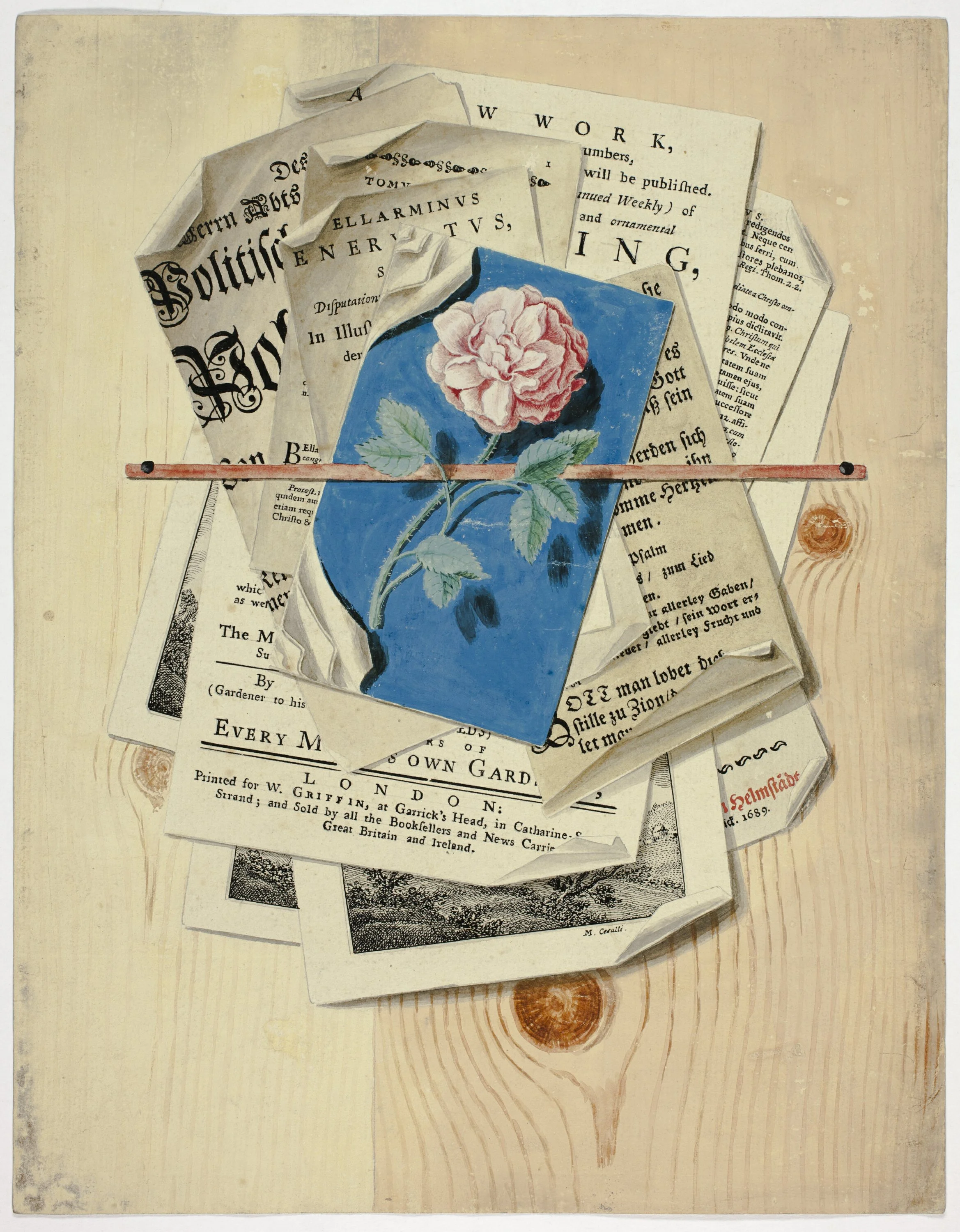Flowers in Literature: Finding Spring Through the Written Word
Trompe l'Oeil of Posted Notices and Prints by Martin Cerulli.
The arrival of spring has long inspired writers to turn their pens toward blooming landscapes, evoking not only the verdant beauty of nature but also the renewal and fragility inherent in the season. From classic prose to contemporary fiction, the motif of flowers offers a vibrant lens through which to explore themes of love, loss, and transformation. Let us step into this perennial garden, where words blossom as vividly as daffodils after winter’s thaw.
The Eternal Return: Classic Literature’s Blossoms
Few symbols in literature capture the vitality and brevity of life as poignantly as flowers. Shakespeare’s works are replete with floral imagery, from Ophelia’s rueful bouquet in Hamlet to the enchanted forest of A Midsummer Night’s Dream. Flowers in Shakespeare often reflect the complexities of human emotion—Ophelia’s garlands embody innocence and grief, while Titania’s enchanted love for Bottom occurs amidst a landscape of heady blooms, signaling both folly and magic. The famed "rosemary for remembrance" from Hamlet suggests flowers’ role in the interplay between memory and emotion, a motif that echoes through countless works that followed.
Moving from Elizabethan England to the Romantic period, William Wordsworth’s “I Wandered Lonely as a Cloud” transforms the daffodil into a symbol of transcendent joy. Here, the “dance” of the flowers is not merely a physical description but an embodiment of the harmony between nature and human imagination. Wordsworth’s idyllic portrayal reinforces the Romantic ideal that nature serves as a wellspring of emotional and spiritual sustenance. Similarly, Emily Dickinson’s poetry treats flowers with both reverence and curiosity. Her “A Route of Evanescence” describes the fleeting, almost mystical quality of spring blossoms, reflecting her larger preoccupation with mortality and immortality. Dickinson often wove flowers into her verse as messengers of ephemeral beauty and profound truths, showing their power to both conceal and reveal life’s enigmas.
Modern Blooms: Contemporary Explorations
In more recent literature, flowers continue to serve as powerful metaphors, though often with an added layer of complexity and social commentary. In Toni Morrison’s Sula, wildflowers are imbued with themes of freedom and wildness, symbolizing the uncontained spirit of the titular character. The roadside flowers in Morrison’s novel—often unnoticed by passersby—become a metaphor for the resilience and overlooked beauty of marginalized lives. Flowers in Morrison’s hands are not merely ornamental but hold deeper implications about survival and identity in a world fraught with hardship.
Similarly, Ali Smith’s Spring uses the season’s blooms as a counterpoint to the social and political frictions of contemporary life. The novel’s floral imagery—hawthorn trees and burgeoning gardens—provides a sense of hope and regeneration amidst human conflict. Smith’s choice of flora mirrors the resilience of the natural world against human-imposed boundaries, suggesting the possibility of renewal even in the most divided times. This interplay between the botanical and the societal brings a modern urgency to the timeless theme of growth.
Meanwhile, in Margaret Atwood’s The Handmaid’s Tale, flowers are layered with duality, symbolizing both fertility and oppression. The meticulously arranged gardens of Gilead, lush and fertile, starkly contrast the rigid control imposed on the women tasked with bearing children. Flowers here become an ironic reflection of beauty forced into confinement, underscoring the tension between natural vitality and imposed sterility.
Symbolism Across Cultures
The literary significance of flowers transcends Western traditions, enriching narratives across cultures with their unique symbolism. In Japanese literature, the cherry blossom, or sakura, is a potent symbol of ephemerality and beauty. Yasunari Kawabata’s Snow Country employs the fleeting bloom of the cherry tree to parallel the impermanence of the protagonist’s relationships. The annual bloom-and-fall cycle of the sakura carries profound cultural and spiritual resonance, reflecting Buddhist notions of transience and acceptance.
Similarly, in Persian poetry, roses often convey both the beauty and pain of love, as seen in the works of Rumi and Hafez. In Rumi’s verse, the rose becomes an object of divine beauty, representing both the beloved and the unattainable spiritual truth. Hafez often uses gardens lush with roses and nightingales to evoke a sensual yet sacred atmosphere, one where human longing and divine aspiration converge.
In Chinese poetry, the lotus flower holds a revered position as a symbol of purity and resilience. Emerging unblemished from murky waters, the lotus captures the ability to remain untouched by corruption. The Tang Dynasty poets frequently used the lotus to underscore themes of personal virtue and transcendence amidst life’s challenges.
A Universal Bouquet
Whether a wildflower sprouting through cracks in the pavement or a meticulously cultivated rose garden, flowers in literature remind us of life’s fleeting yet enduring beauty. As we step into spring, perhaps the words of these writers can prompt us to pause, observe, and savor the blossoms around us. Their petals may wilt, but their symbolism, like great literature, remains perennial. The simple act of noticing a flower can be transformative, offering a moment of stillness and connection in an ever-changing world. These floral imprints on the page remind us that, like spring itself, renewal and beauty are always within reach.


